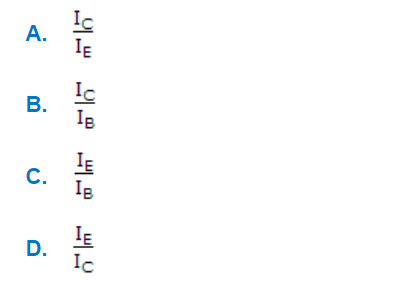Question

a.
A
b.
B
c.
C
d.
D
Posted under Electronics and Communication Engineering
Interact with the Community - Share Your Thoughts
Uncertain About the Answer? Seek Clarification Here.
Understand the Explanation? Include it Here.
Q. In bipolar transistors dc current gain is
Similar Questions
Explore Relevant Multiple Choice Questions (MCQs)
Q. Which is correct for a vacuum triode?
View solution
Q. Figure represents a
View solution
Q. To avoid thermal runaway in the design of an analog circuit, the operating point of the BJT should be such that it satisfies the condition.
View solution
Q. Hall coefficient KH and charge density ρ are related as
View solution
Q. In p type semiconductors the conduction due to holes ( = σp ) is (where e = charge on hole, μp is hole mobility and ρ is hole concentration)
View solution
Q. The Ebers-moll equation for IE in CB configuration is given by
View solution
Q. The small signal input impedance of a transistor whose output is shorted for the measuring signal is
View solution
Q. The dipole moment per unit volume as a function of E in the case of an insulator is given by (symbols have the usual meaning).
View solution
Q. The diode and the moving coil milliammeter of figure are assumed to be ideal. The meter reading is
View solution
Q. The V-I characteristic of a semi-conductor diode is shown in figure. From this figure it can be concluded that
View solution
Q. Which of the following expressions may be used to correctly describe the temperature (T) variation of the intrinsic carrier density (ni) of a semiconductor?
View solution
Q. Figure represents a
View solution
Q. Figure shows the terminals of a transistor in plastic package TO 18. Then
View solution
Q. The network shown in the figure represents a
View solution
Q. In a junction transistor biased for operation at emitter current 'IE' and collector current 'IC' the transconductance 'gm' is.
View solution
Q. CE saturation resistance of n-p-n transistor is
View solution
Q. Typical values of h parameters at about 1 mA collector current for small signal audio amplifier in CE configuration are :
View solution
Q. R.M.S. value of the waveform shown will be
View solution
Q. For a UJT if
R1 = Resistor from emitter to the base 1
R2 = Resistor from emitter to the base 2 and RBB = R1 + R2,
then the intrinsic stand off ratio (η) is
View solution
Q. The kinetic energy of free electrons in a metal is (where k is de-Broglie wave number of the electrons)
View solution
Recommended Subjects
Are you eager to expand your knowledge beyond Electronics and Communication Engineering? We've handpicked a range of related categories that you might find intriguing.
Click on the categories below to discover a wealth of MCQs and enrich your understanding of various subjects. Happy exploring!








